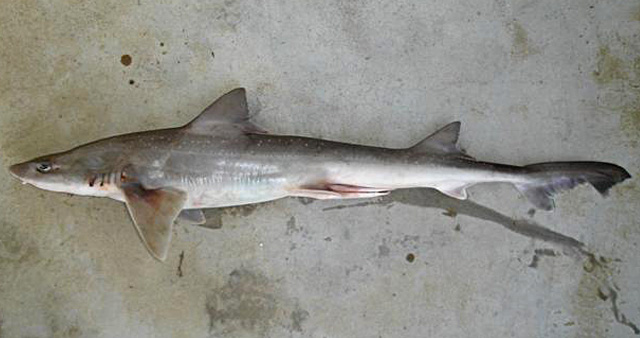| Triakidae (Houndsharks), subfamily: Triakinae |
| 157 cm TL (male/unsexed); 175 cm TL (female); max.weight: 31 kg; max. reported age: 16 years |
|
demersal; marine; depth range 0 - 403 m, oceanodromous |
| Eastern Indian Ocean: endemic to southern Australia, from Western Australia through Bass Strait to Tasmania and northern New South Wales. Possibly extends northward to southern Queensland and Shark Bay in Western Australia. Confused with another undescribed species whose southern distribution extends to Dampier (20°40'S) (possibly Shark Bay) in the west and Bowen (20°S) (possibly Coffs Harbor) in the east. There is a single stock of gummy sharks in the area, however, regional stock differences might still exist. |
|
|
| An inshore and offshore shark found from intertidal waters (Ref. 13563) to a depth of 350 m. Feeds on crustaceans, marine worms and small fishes (Ref. 13563), also cephalopods. Forms schools by sex and size . Ovoviviparous (Ref. 50449). Newborn and juvenile gummy sharks are found in many areas across southern Australia, but no well-defined nursery areas have been identified. These sharks are capable of long migrations, females traveling longer distances than males (Ref. 6390). Utilized fresh for human consumption (Ref. 6871). Maximum length data for female species is taken from Ref. 6390. |
|
Least Concern (LC); Date assessed: 15 April 2015 Ref. (130435)
|
| harmless |
|
Type locality of Mustelus antarcticus and Mustelus walkeri, north-east of Hinchinbrook Island, Queensland and which is known from upper continental slope of northeastern Australia from off Hinchinbrook I. to Moreton I., Queensland , 52-403 m (Ref. 76951).
Commercial fishery: Major component of the Southern Shark Fishery. The meat is sold under the name 'flake' and is very popular in Victoria and Tasmania. Its catch increased after 1972 when the sale of school sharks was banned due to their high mercury content. Aside from the specialist shark fishers, gummy sharks are often taken by other fishers as a substitute when their main fishery is affected by closed seasons or poor catch rates. Also taken as bycatch by demersal otter trawlers in the South East Fishery. About 10% of the total Australian gummy shark catch comes from waters off Western Australia (Ref. 6080). Fishing methods include monofilament gillnets, longlines, handlines, and droplines. Fishers in Bass Strait use 6-inch gillnets while 7-inch gill nets are being utilized in South Australia. Longlines are still being used by fishers from Tasmania.
Recreational fishery: Handlines and gillnets (only in Tasmania) are being used by recreational fishers in bays, inlets and ocean beaches. The heaviest specimen recorded from the recreational fishery was caught in Western Australia at 23.9 kg. (Australian Anglers Association records).
Resource status: Overfishing has occurred in the Southern Shark Fishery as evidenced by trends in catch per unit of effort and fishery simulation models. Assessments done in 1991 and 1992 concluded that gummy sharks are overexploited. An estimated sustainable yield for gummy and school shark was 1200 t per annum (1992 estimate) which was less than half the 1993 catch of both species. This estimate, however, is quite uncertain due to various factors. The shark fishery resource in Western Australia was fully exploited (in 1993) as suggested by the downward trend in the gummy shark catch per unit effort (Refs. 13841, 13842). Also Ref. 244, 7300, 13563. |
Source and more info: www.fishbase.org. For personal, classroom, and other internal use only. Not for publication.

